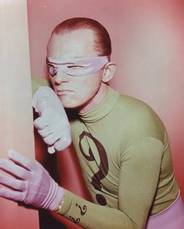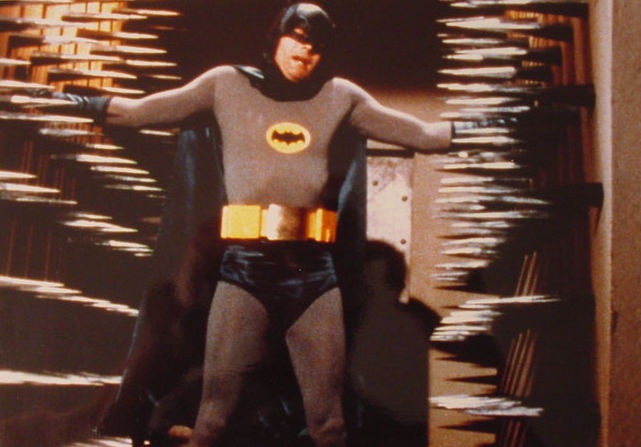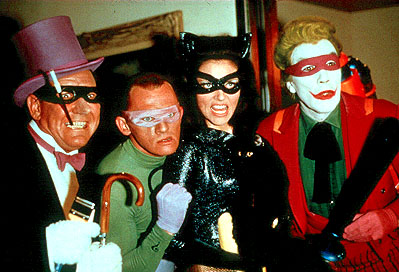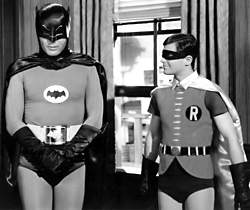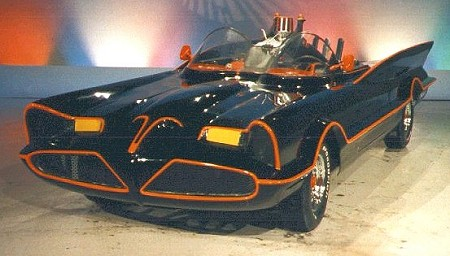SYNOPSIS
Cartoonist
Bob Kane's
Batman
first appeared in comic-book
form in Detective Comics in 1939 and
was featured on radio's Superman series and in two movie serials in the
late 1940's. In January
of 1966, it took television by storm. But in slightly two years, it blew itself
out.
Batman
was the ultimate "camp" show of the 1960's and was definitely not to
be taken seriously, even by those who acted in it. The fight scenes were
punctuated by animated "Pows," "Bops,"
"Bangs," and "thuds" that flashed on the screen when a blow was
struck, obliterating the actors. The situations were incredibly contrived and the acting was
intentionally overdone
by everyone except Adam West, who was so wooden that he was hilarious.
The
general structure of the series was true to Bob Kane's original comics. Bruce Wayne
had been orphaned in his teens when his parents were killed by a criminal.
Inheriting their fortune, Bruce built a complex crime lab under the Wayne mansion, and, as
the mysterious Batman, waged war on the evildoers
who plagued Gotham City. His young ward, the orphaned Dick Grayson,
joined him; they were known individually as the Caped Crusader and The
Boy Wonder, and together as The Dynamic Duo. The only
person who knew their real identity was the Wayne family butler, Alfred,
who had raised Bruce after his parents' murder.
In addition to the underground Batlab, (where every device was carefully labeled with its function),
used a marvelously equipped car, the Batmobile, to chase and apprehend
criminals. Whenever their services were needed, Police Commissioner Gordon could
summon them with the searchlight-like Batsignal or
call them on the special Batphone.
Batman
was an overnight sensation when it premiered in 1966, airing two-part stories
that ran on Wednesday and Thursday. The climax of the first part always
left the pair in a dire predicament from which they managed to extricate
themselves on the
following night. The public's fancy was caught by the silliness, the absurdity,
and Robin's horrible puns (attempting to scale a building with Batman in the
first episode, he was heard to say "Holy fire
escape, Batman,". Both the Wednesday and Thursday episodes ranked among the
ten most popular programs of the 1965-1966 season.
Appearing as a guest villain on the show
became something of a status symbol.
Among the more celebrated foes were The Penguin (Burgess Meredith), The Joker (Cesar Romero),
The Riddler (Frank Gorshin and later, John Astin), Egghead (Vincent Price), King Tut
(Victor Buono), and the Catwoman (played variously by Julie Newmar, Lee Ann Meriwether
and Eartha Kitt).
By
the fall of 1967, however, the novelty had passed and the ratings began to fall.
A new role was added, the part of Commissioner Gordon's daughter Barbara,
a young librarian who fought crime on her own as Batgirl, and who regularly
teamed up
with Batman and Robin (she had also been in Kane's comics). But it didn't help.
Cut back
to once a week in the fall of 1967, the surprise hit of 1966 was gone by the following spring.
The Dynamic Duo didn't completely
disappear from network television, however. Six months after the ABC prime-time
series faded from the air,
the animated
Batman-Superman Hour premiered on CBS' Saturday
morning schedule. The first animated version lasted two seasons. Batman and Robin
surfaced
again on ABC's
Super Friends in the fall of 1973. From
February 1977 to September 1978, CBS
The New Adventures of Batman with Adam
West and Burt Ward providing the voices, and Super Friends
on ABC, despite numerous title changes, remained on the air until 1985.
They resurfaced as part of
The New Batman/Superman
Adventures on the WB
network in September 1997, where they aired on Saturday mornings and weekday
afternoons until the fall of 2000.



